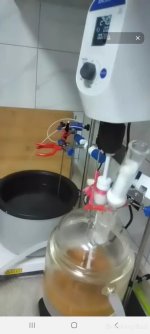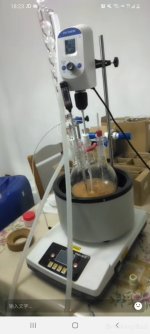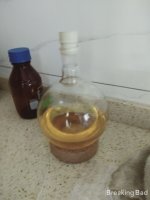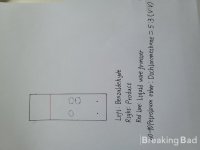- Language
- 🇺🇸
- Joined
- Feb 26, 2023
- Messages
- 45
- Reaction score
- 31
- Points
- 18
I encountered a problem. I followed the article. After adding sodium ethoxide, I stirred for an hour under a strict anhydrous environment below 10°C. After that, I started to raise the temperature to 60°C to prepare for the option of stirring for an hour. But after a little heating, the temperature in the device spontaneously rose out of control and quickly, and after only a few minutes, my thermometer showed a breakthrough of 130°C, so I want to ask, is this normal? Has anyone encountered it?The first picture is the process of stirring for 1 hour below 10°C after adding sodium ethoxide. I inserted a drying tube filled with anhydrous magnesium sulfate on the device to maintain anhydrous conditions. Since my circulation device can only cool down, I transferred the second stage of heating to the flask. The heating method is oil bath heating, but I just used the temperature of 65°C for a few minutes, and the temperature in the flask was out of control. As it rises, the thermometer shows that it exceeds 130 ℃ very quickly, so fast that I don't even have time to start the condensate water cycle in the condenser pipe, and then it becomes the state in the second picture.


Last edited by a moderator:
G.Patton
Expert
- Joined
- Jul 5, 2021
- Messages
- 2,992
- Solutions
- 3
- Reaction score
- 3,384
- Points
- 113
- Deals
- 1
Hello, has the self-heating happen violently or slowly? It is quite interesting.
↑View previous replies…
- Language
- 🇺🇸
- Joined
- Feb 26, 2023
- Messages
- 45
- Reaction score
- 31
- Points
- 18
I guess the sodium chloride may not be effective anymore, because when I use dichloromethane to extract, the dichloromethane is abnormally in the upper layer, which means that the density of the water layer is already very high, and the sodium chloride may no longer be able to extract it. Increase density.Also, since I have a rotary evaporator that makes large-scale solvent recycling possible, I don't incur much cost in using solvent extraction reagents in large quantities.
regarding the patent, I found a patent published in 2009 and bought it. Its process looks very mature and simple. I plan to try this method after the added reagents arrive. The raw materials are still benzaldehyde and 2 - methyl chloropropionate.
regarding the patent, I found a patent published in 2009 and bought it. Its process looks very mature and simple. I plan to try this method after the added reagents arrive. The raw materials are still benzaldehyde and 2 - methyl chloropropionate.
- Language
- 🇺🇸
- Joined
- Feb 26, 2023
- Messages
- 45
- Reaction score
- 31
- Points
- 18
This is a patent applied for in China. It seems that the scope of validity is only in China, and there is no English version of the full text, so I did not find the DOI number of this patent. The original text is written in Chinese, and the publisher is from Modern Times, Xi'an City, Shaanxi Province, China Institute of Chemistry, the phone number and email address left by the author are 029-88291460 and [email protected]. But you can pay attention to the content I will post next. Once I verify the reliability of this process, I will post all the detailed processes and precautions. This will take about a week or so from now.
- Language
- 🇺🇸
- Joined
- Feb 26, 2023
- Messages
- 45
- Reaction score
- 31
- Points
- 18
- Joined
- Dec 16, 2022
- Messages
- 86
- Reaction score
- 18
- Points
- 8
- Language
- 🇺🇸
- Joined
- Feb 26, 2023
- Messages
- 45
- Reaction score
- 31
- Points
- 18
I have published the patent process and practice.
 bbgate.com
bbgate.com
Patented process from benzaldehyde to BMK glycidyl ester to P2P
This article provides you with a patented synthesis process from benzaldehyde to BMK glycidyl ester to P2P. This process comes from a patent published in 2009. The original text used 4-methoxybenzaldehyde to synthesize 4-methoxyphenylacetone. I replaced it with benzaldehyde to synthesize...
 bbgate.com
bbgate.com




